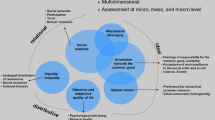Abstract
A previous study of the effects of overcrowding on social behavior is discussed and replicated in this article. Consideration of two major methodological problems — the construction of the class and ethnicity indices and the measurement of social class — leads to reanalysis of the data and to results differing in several significant respects from the original results. Although these new results do not provide a definitive answer to the question of the effects of population density on social pathologies, they do show that studies of the problem are subject to several, possibly severe, measurement problems. Until these are more adequately dealt with, conclusions regarding the relation between density and human behavior must be both cautious and tentative.
Similar content being viewed by others
References
Blalock, H. M. (1964).Causal Inferences in Nonexperimental Research, Norton, New York.
Choldin, H., and McGinty, M. J. (1972). Bibliography: Population density, crowding, and social relations.Man-Environment Systems 2: 131–155.
Davis, K. (1965). Some demographic aspects of poverty in the U.S. In Gordon, M. S. (ed.),Poverty in America, Chandler, San Francisco, pp. 299–319.
Dentler, R. (1967).Major American Social Problems, Rand-McNally, Chicago.
Duncan, O. D., and Davis, B. (1953). An alternative to ecological correlation.American Sociological Review 18: 665–666.
Fischer, C. S., Baldassare, M., and Ofshe, R. J. (1974). Crowding studies and urban life: A critical review. Working Paper No. 242, Institute of Urban and Regional Development, University of California, Berkeley.
Galle, O., Gove, W., and McPherson,.J. M. (1972). Population density and pathology: What are the relations for man?Science 176: 23–30.
Goodman, L. (1953). Ecological regression and the behavior of individuals.American Sociological Review 18: 663–664.
Gordon, R. A. (1967). Issues in the ecological study of delinquency.American Sociological Review 32: 927–944.
Hannan, M. (1972).Aggregation and Disaggregation in Sociology, Lexington Books, Lexington, Mass.
Hauser, P., and Kitagawa, E., eds. (1950).Local Community Fact Book for Chicago, 1950, Chicago Inventory, University of Chicago.
Hollingshead, A. B., and Redlich, F. (1968). Social class and psychiatric disorders. In Gorlow, L., and Katkovsky, W. (eds.),Readings in the Psychology of Adjustment, McGraw-Hill, New York, pp. 256–267.
Kitagawa, E., and Taeuber, K., eds. (1960).Local Community Fact Book for Chicago, 1960, Chicago Inventory, University of Chicago.
Loftin, C., and Hill, R. (1974). Regional subculture and homicide: An examination of the Gastil-Hackney thesis.American Sociological Review 39: 714–724.
Menzel, H. (1950). Comment on Robinson's “Ecological correlations and the behavior of individuals.”American Sociological Review 15: 674.
Robinson, W. S. (1950). Ecological correlations and the behavior of individuals.American Sociological Review 15: 351–357.
Tumin, M. (1967).Social Stratification: The Forms and Functions of Inequality, Prentice-Hall, Englewood Cliffs, N.J.
Author information
Authors and Affiliations
Rights and permissions
About this article
Cite this article
Ward, S.K. Methodological considerations in the study of population density and social pathology. Hum Ecol 3, 275–286 (1975). https://doi.org/10.1007/BF01531427
Issue Date:
DOI: https://doi.org/10.1007/BF01531427




